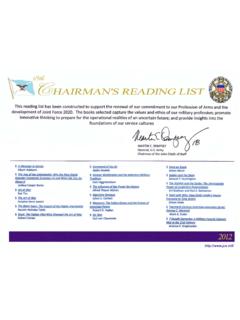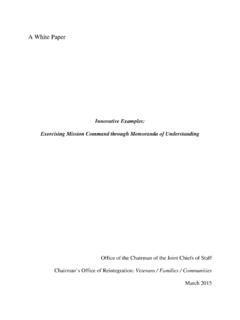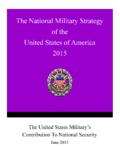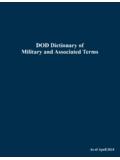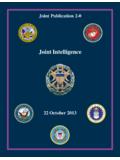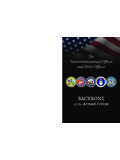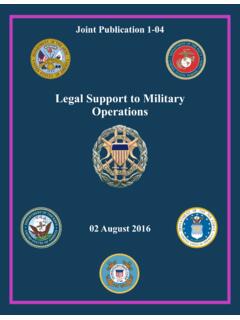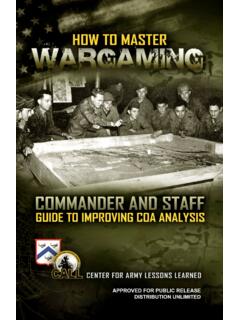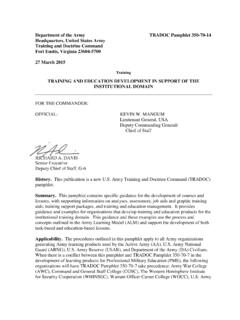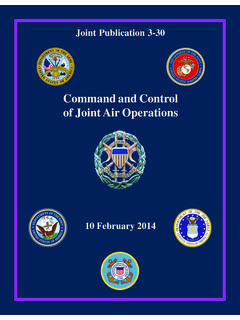Transcription of Joint Task Force Headquarters - Joint Chiefs of Staff
1 DEPAOTMENTFTHEARMY EUNITEDSTATSOAFAMERICRTHISWE'LLDEFENDJ oint Publication 3-33 Joint Task Force Headquarters31 January 2018 i PREFACE 1. Scope This publication provides Joint doctrine for the formation and employment of a Joint task Force (JTF) Headquarters to command and control Joint operations. It provides guidance for the JTF Headquarters to plan, prepare, execute, and assess JTF operations. 2. Purpose This publication has been prepared under the direction of the Chairman of the Joint Chiefs of Staff (CJCS). It sets forth Joint doctrine to govern the activities and performance of the Armed Forces of the United States in Joint operations, and it provides considerations for military interaction with governmental and nongovernmental agencies, multinational forces, and other interorganizational partners.
2 It provides military guidance for the exercise of authority by combatant commanders and other Joint Force commanders (JFCs), and prescribes Joint doctrine for operations and training. It provides military guidance for use by the Armed Forces in preparing and executing their plans and orders. It is not the intent of this publication to restrict the authority of the JFC from organizing the Force and executing the mission in a manner the JFC deems most appropriate to ensure unity of effort in the accomplishment of objectives. 3. Application a. Joint doctrine established in this publication applies to the Joint Staff , commanders of combatant commands, subordinate unified commands, Joint task forces, subordinate components of these commands, the Services, and combat support agencies. b. The guidance in this publication is authoritative; as such, this doctrine will be followed except when, in the judgment of the commander , exceptional circumstances dictate otherwise.
3 If conflicts arise between the contents of this publication and the contents of Service publications, this publication will take precedence unless the CJCS, normally in coordination with the other members of the Joint Chiefs of Staff , has provided more current and specific guidance. Commanders of forces operating as part of a multinational (alliance or coalition) military command should follow multinational doctrine and procedures ratified by the United States. For doctrine and procedures not ratified by the US, commanders should evaluate and follow the multinational command s doctrine and procedures, where applicable and consistent with US law, regulations, and doctrine. For the Chairman of the Joint Chiefs of Staff : KEVIN D. SCOTT Vice Admiral, USN Director, Joint Force Development Preface ii JP 3-33 Intentionally Blank iii SUMMARY OF CHANGES REVISION OF Joint PUBLICATION 3-33 DATED 30 JULY 2012 Adds a characterization of threats that are increasingly transregional, multidomain, and multi-functional in nature; adds three characterizations of the operational status of a Joint task Force (JTF): operational, contingency, and standing; adds a paragraph on the combined JTF Headquarters (HQ); and clarifies the role of Joint task Force -state in Chapter I, Introduction.
4 Updates the roles of various organizations that support the JTF (such as Defense Threat Reduction Agency, Joint Personnel Recovery Agency, and the US Transportation Command s Joint Enabling Capabilities Command); updates explanation of Joint individual augmentation; and adds three optional J-Code directorates of a Joint Staff : training and education directorate (J-7), resource management and financial support directorate (J-8), and civil-military operations directorate/interagency operations directorate (J-9) to Chapter II, Forming and Organizing. Adds paragraphs on special operations task Force and Joint special operations task Force as examples of functional component commands to Chapter III, Subordinate Commands. Revises the explanation of information management and expands the explanation of battle rhythm management in Chapter IV, Command and Control.
5 Significantly revises the explanation of the Joint manpower development process for more logical information flow in Chapter V, Manpower and Personnel Directorate. Clarifies the role of the Joint intelligence support element with respect to the JTF J-2 in Chapter VI, Intelligence Directorate. Adds an explanation of commander s communication synchronization (CCS); the J-3 s role in facilitating CCS; and the use of information-related capabilities to create effects, accomplish tasks, or achieve objectives and adds a description of the counter threat finance cell and an explanation of the role of the request for forces (RFF) (RFF manager) to Chapter VII, Operations Directorate. Updates information on contract support, contracting, and operational contract support and adds a paragraph on the operational contract support integration cell to Chapter VIII, Logistics Directorate.
6 Revises the explanation of operational art to be consistent with the Joint Publication (JP) 3-0, Joint Operations, 17 January 2017, in Chapter IX, Plans and Policy Directorate. Summary of Changes iv JP 3-33 Revises the description of the JTF J-6 role and responsibilities to be consistent with the JP 6-0, Joint Communications System, 10 June 2015, in Chapter X, Communications System Directorate. Adds a new Chapter XI, Training and Education Directorate, as an optional directorate for a JTF HQ. Adds a new Chapter XII, Resource Management and Financial Support Directorate, as an optional directorate for a JTF HQ. Adds a new Chapter XIII, Civil-Military Operations Directorate/Interagency Operations Directorate, as an optional directorate for a JTF HQ. Adds a new Chapter XIV, Special and Personal Staff , in place of the previous Appendix C, commander , Joint Task Force Personal, and Special Staffs, and subordinate annexes.
7 Adds a new Annex A, Checklist for the Chief of Staff , to Appendix A, Checklists. Updates and moves the Checklist for Liaison Personnel to its own Appendix C, Liaison Officers. Reorganizes content as required for more logical flow of related information. Reduces redundancies and simplifies explanations where appropriate. Updates references, terms, and definitions. v TABLE OF CONTENTS EXECUTIVE SUMMARY .. xi CHAPTER I INTRODUCTION General .. I-1 Joint Functions .. I-5 Interorganizational Cooperation Considerations .. I-5 Types of Joint Task Forces .. I-8 Combined Joint Task Force Headquarters .. I-9 Joint Task I-9 CHAPTER II FORMING AND ORGANIZING General ..II-1 Section A. Forming ..II-2 Forming Options ..II-2 Options for Augmenting the Headquarters ..II-3 Section B.
8 Organizing ..II-8 Command and Staff Roles and Responsibilities ..II-8 Staff Organization ..II-12 Staff Integration ..II-24 Liaison Personnel ..II-24 CHAPTER III SUBORDINATE COMMANDS Task Organization and Common Responsibilities .. III-1 Service Component Commands .. III-2 Functional Component Commands .. III-3 Subordinate Joint Forces .. III-6 CHAPTER IV COMMAND AND CONTROL General .. IV-1 Command and Control Factors .. IV-1 Management Processes .. IV-14 Table of Contents vi JP 3-33 CHAPTER V MANPOWER AND PERSONNEL DIRECTORATE General .. V-1 Organization .. V-2 Responsibilities .. V-2 Personnel V-14 CHAPTER VI INTELLIGENCE DIRECTORATE General .. VI-1 Organization .. VI-2 Responsibilities .. VI-4 Intelligence Disciplines and Sources .. VI-7 Collection Management .. VI-7 Supported Combatant commander s Joint Intelligence Operations Center.
9 VI-7 Joint Intelligence Support Element .. VI-8 Intelligence Centers and Other Support .. VI-9 Multinational Intelligence Sharing Agreements .. VI-12 CHAPTER VII OPERATIONS DIRECTORATE General .. VII-1 Organization .. VII-1 Responsibilities .. VII-11 Joint Operations Center .. VII-14 Current Operations .. VII-16 Future VII-16 Cyberspace Considerations .. VII-17 CHAPTER VIII LOGISTICS DIRECTORATE General .. VIII-1 Organization .. VIII-2 Responsibilities .. VIII-4 Authority .. VIII-7 Planning Considerations .. VIII-8 Multinational Logistic Considerations .. VIII-11 United Nations VIII-12 Other Logistic Considerations .. VIII-13 Operational Contract Support Considerations .. VIII-13 Host-Nation Support Considerations .. VIII-14 Logistic Supporting Agencies and VIII-16 Logistics Staff Organizations.
10 VIII-17 Table of Contents vii CHAPTER IX PLANS AND POLICY DIRECTORATE General .. IX-1 Organization .. IX-2 Responsibilities .. IX-2 Adaptive Planning and Execution System .. IX-5 Operational Art, Operational Design, and Joint Planning Process .. IX-5 Joint Planning Group .. IX-7 Assessment .. IX-12 CHAPTER X COMMUNICATIONS SYSTEM DIRECTORATE General .. X-1 Organization .. X-3 Responsibilities .. X-3 Requirements .. X-8 Cyberspace Considerations .. X-9 Network and Information Technology Support .. X-10 Global Command and Control System .. X-10 Information Sharing .. X-10 CHAPTER XI TRAINING AND EDUCATION DIRECTORATE General .. XI-1 Organization .. XI-1 Responsibilities .. XI-2 Training the Joint Task Force Headquarters .. XI-2 Lessons Learned .. XI-3 CHAPTER XII RESOURCE MANAGEMENT AND FINANCIAL SUPPORT DIRECTORATE General.
